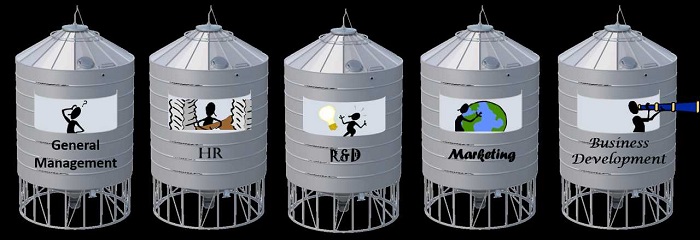“Silos – and the turf wars they enable – devastate organisations. They waste resources, kill productivity, and jeopardize the achievement of goals.”
Patrick Lencioni
Silos in business are real, they exist, they are not just for grain or concrete storage.
Silo mentality/Silo effect is essentially when certain departments or functions do not wish to share information with others in the same company. This type of mentality will have an adverse effect on a business.
As a business grows functions and departments are added eg Operations, I.T, Marketing, Commercial, HR, Technical etc. With this growth comes added process and complexity. Functions have function heads with their own teams. Each function or department are set strategic goals, these may or may not be aligned – this is when silo mentality can appear.
What effect does silos have on a business?
Silos in business can have an adverse effect on business and slow growth down due to the following:
- Inefficiencies when it comes to overall operations
- Duplication of work
- Reduced employee morale
- Increased internal politics
- Lack of decision making
- Poor collaboration and teamwork
- Reduction of a productive company culture
- Causes frustrations for customers who are awaiting an answer about a product query
- Demise of a productive company culture
Breaking down silos
Businesses can take a few simple steps to help break down silos, these can include:
- Open planned offices – encourage open plan offices, this gives teams more exposure to each other and helps build relationships.
- Review organisation structures – when introducing new roles or when writing new job descriptions consider ways to encourage more cross functional working and the sharing of knowledge eg combine departments or create roles that overlap two areas eg commercial and technical.
- Set common goals – develop goals and strategies that encourage collaboration across functions.
- Define shared accountabilities – be clear on accountabilities for teams, both individually and cross functional.
- Create relaxed collaborative space – create social spaces for teams to bump into each other, this can be during work breaks and lunch
- Cross functional projects – ensure projects has multi-function participation, this ensures the sharing of knowledge and the development of cross functional relationships.
- Cross functional programs – when designing development programs eg graduate programs or supervisory development programs ensure participants get exposure or the opportunity to work in different areas of the business.
Benefits of breaking down silos in work
Introducing some of the above changes will reap benefits, these could include:
- Great collaboration and relationships across functions
- Helps encourage knowledge transfer between functions
- Reduces duplicated work
- Creates process efficiencies
- Improved employee retention
It is the role of leaders to facilitate the reduction of silos in a business. By introducing some of the above measures you can move towards a better culture, one with less politics, less frustrations, greater teamworking and collaboration.
It is the responsibility of the leadership team to recognise this and rise above to create effective, long-term solutions that are scalable, executable, and realistic. Breaking down silos will make for better business.
If People HQ can help with your HR strategy and help reshape your organisation reach out today to arrange a complimentary consultation.



Recent Comments